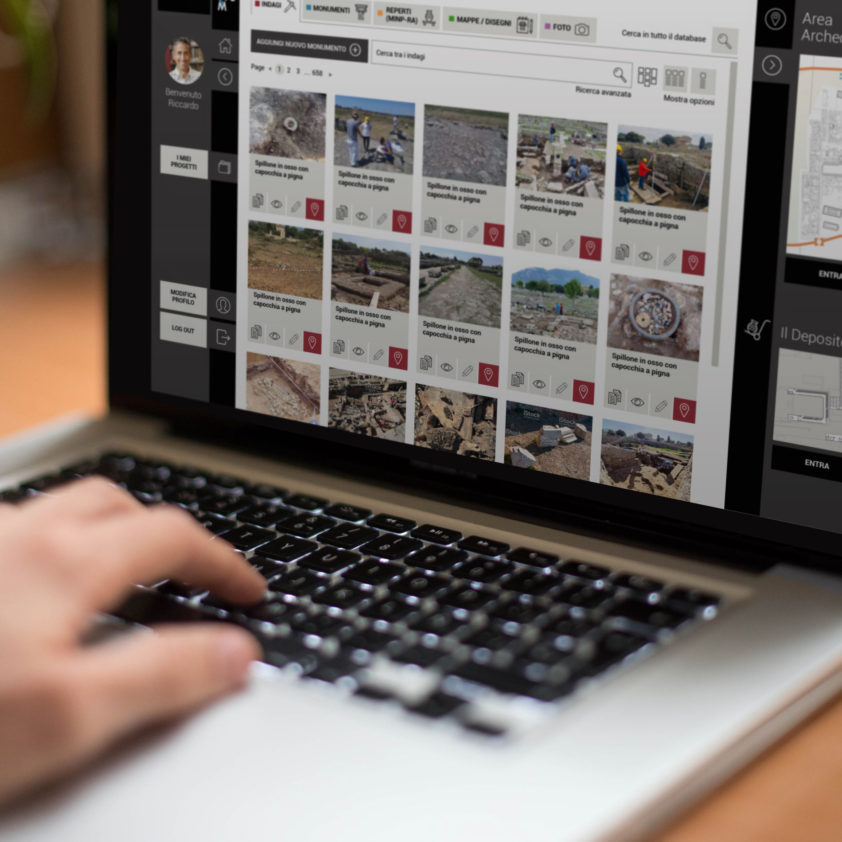Sistema Omnia, heritage cataloguing
The Roman Forum, together with the Colosseum, the Palatine Hill and the adjacent archaeological areas, is one of the most complete and emblematic sites of Roman civilisation. The Archaeological Park of the Colosseum safeguards this legacy preserving the memory of one of the most influential civilisations in history.
Parco archeologico del Colosseo entrusted Visivalab with the development of its new system for cataloguing, centralizing and geolocating its digitized archives. OMNIA is a cutting-edge tool, tailored to the specific needs of the site, that not only facilitates access to its vast heritage and promotes its study and conservation, but also allows for meaningful connections between elements, opening up new pathways for interdisciplinary research that transcends traditional preservation.
CLIENT Parco Archeologico del Colosseo
YEAR 2022-2024
FEATURES
-
Cataloguing, management and research system
-
Based on big data
-
Centralisation of digitised data
-
Geolocation of data
-
UX/UI design
-
Designed for different audiences (professionals and general public)
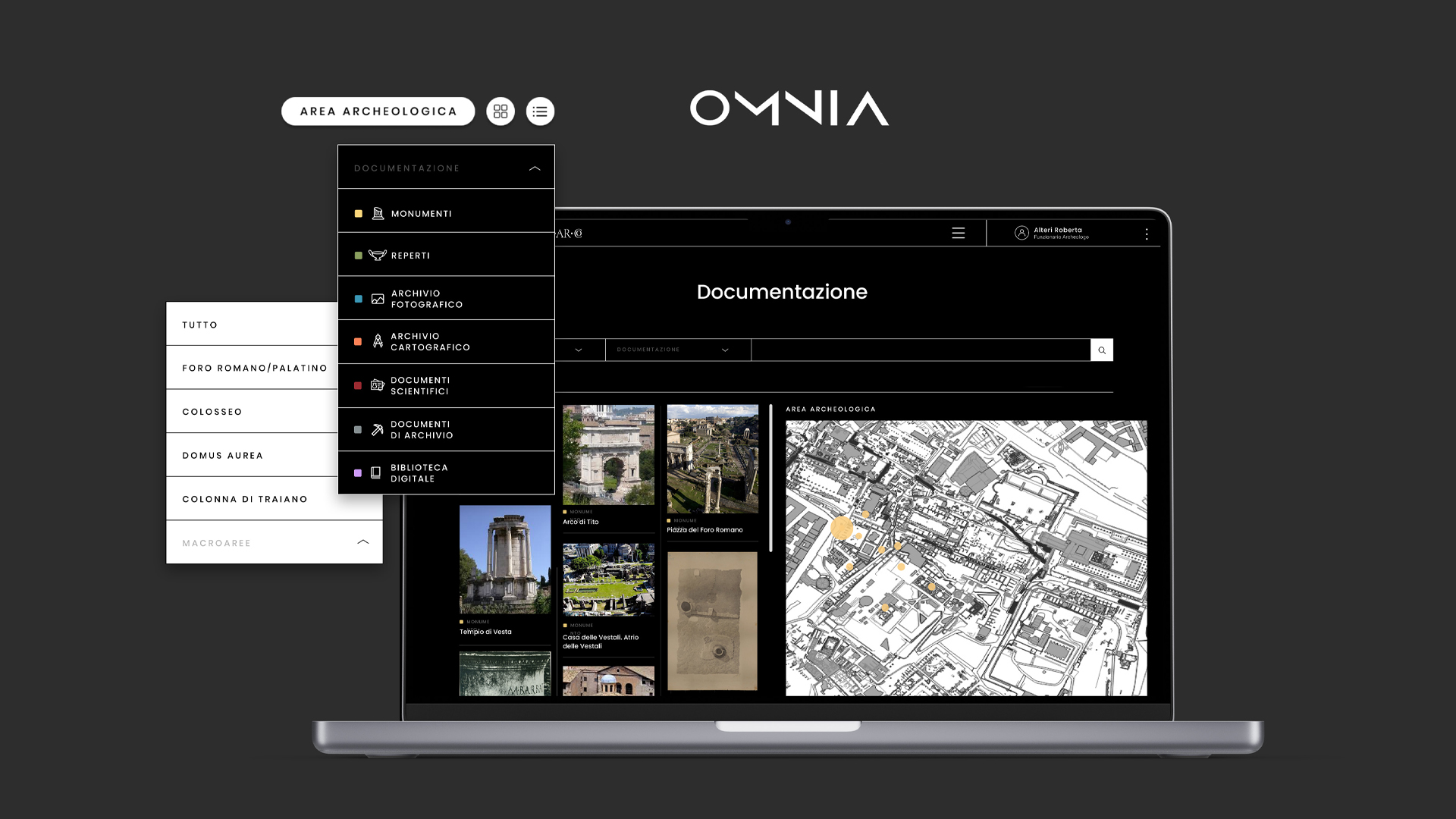
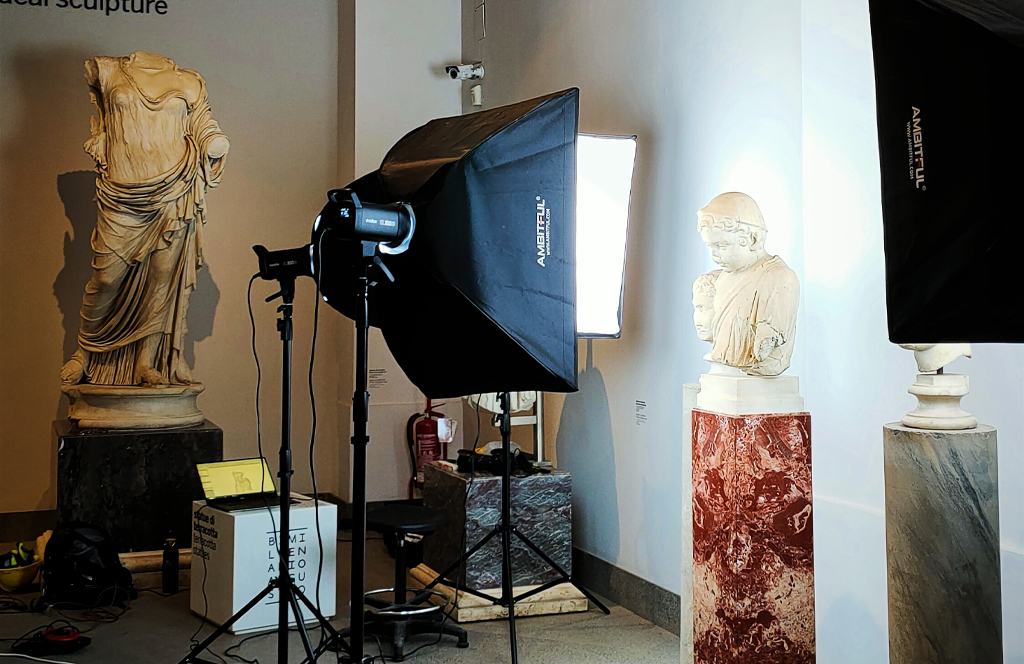
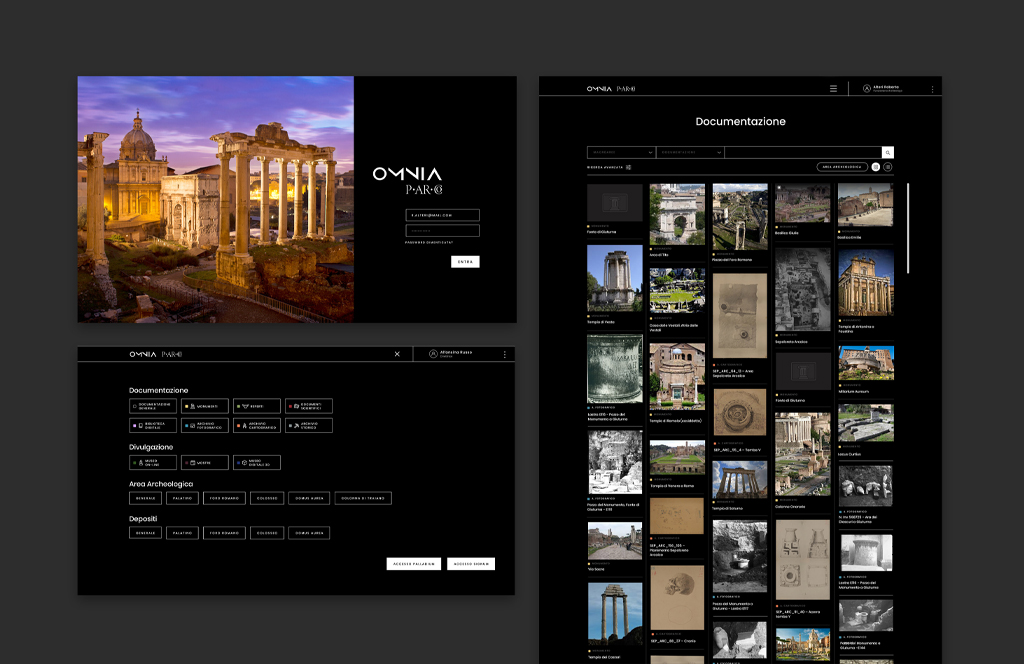
Project
The result is an advanced system that centralizes, standardizes and geolocates the digitized archives of the Parco del Colosseo, thus facilitating the protection, conservation and study of the heritage.
With over 160,000 indexed materials, it offers in-depth and agile consultation thanks to the integration of historical data and artificial intelligence techniques, capable of establishing meaningful connections between items. This approach, based on a big data system, aims to improve the search experience and enhance the analysis of information.
OMNIA is organized into three main research sections: Documentation, Archaeological Area and Deposits.
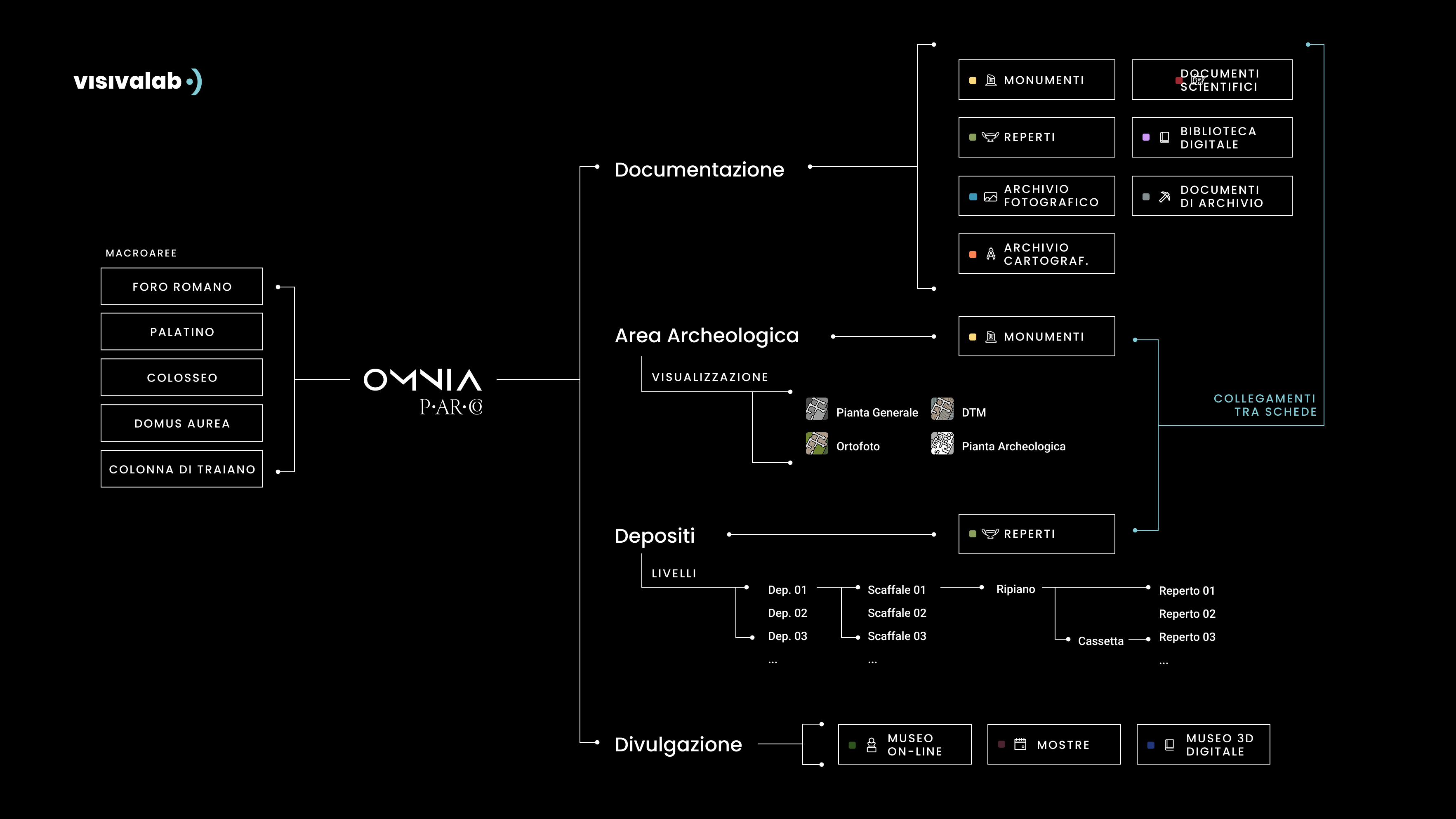
DOCUMENTATION
The system integrates a wide variety of materials and archives, both period and newly created, including monuments, archaeological finds, documentation, three-dimensional scans, as well as graphic, photographic, cartographic and historical archives. Designed to provide an advanced search experience, it allows cross-referencing and integration of diverse information sources, enriching analysis and ensuring circular navigation.
Each element can be geo-referenced to its place of conservation or exhibition, located on a map and linked to its place of origin, restoring the original context and the process of archaeological research.It is also possible to filter by type of file and by macro-areas (sectors) of the park, facilitating specific browsing.
The import and consultation of files complies with the regulations and standards established by the ICCD.
TECHNICAL INFORMATION
SOFTWARE
- Vue
- PHP/Laravel
- MySQL
- Leaflet

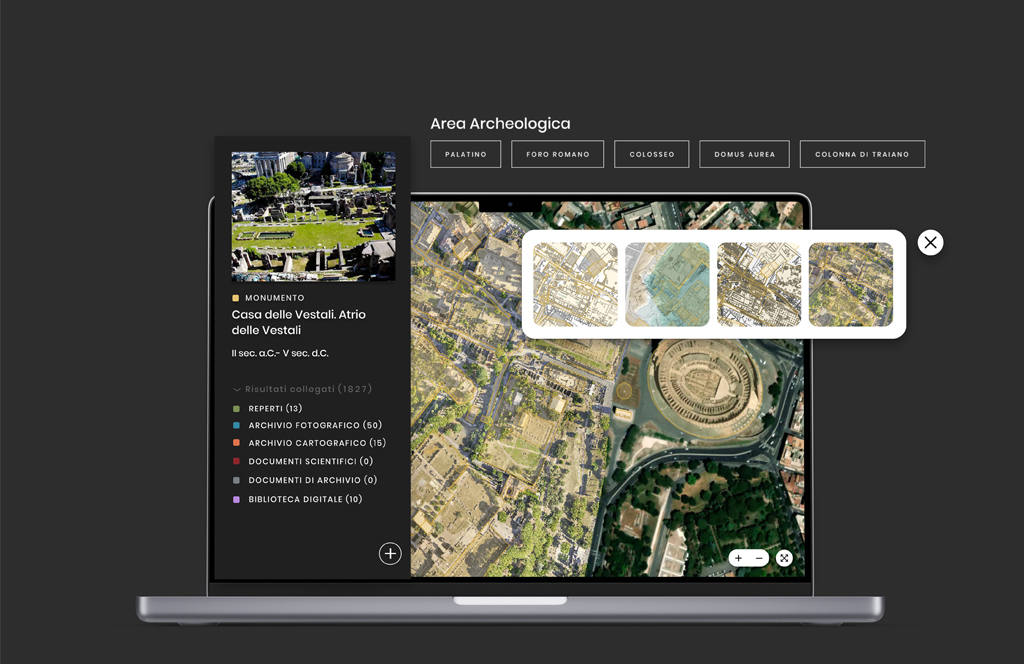
ARCHAEOLOGICAL AREA
This section presents a cartographic interface that allows topographic searches by georeferencing the data. It offers several levels of information through cartographic layers.
DEPOSITS
The system includes a dedicated section for managing the park’s deposits, with detailed plans that provide a clear understanding of the layout and structure of the storage spaces, covering different levels of containers, such as cabinets, shelves and boxes. These plans provide an overview of the stored material, enabling the precise geolocation of findings and optimising their census, inventory and management.
The international conference ‘Depositi invisibili’, organised by the Parco Archeologico del Colosseo, was an event dedicated to unearthing the immense heritage hidden in the deposits of museums and archaeological sites, addressing its management, recovery and valorisation activities. In this framework, Visivalab collaborated in the exhibition of ‘Depositi in mostra’ with two informative videos that enrich the visit experience.
DISSEMINATION AND PUBLIC PORTAL
The system contemplates the possibility to open its resources to the public through a related portal, enabling general access to part of the heritage it houses. In this way, the system turns heritage into a living resource, connecting past, present and future, and inviting collective reflection on humanity’s journey. Leveraging its tag-based structure, the system allows for easy selection of the data to be made accessible. To ensure scientific content is both understandable and engaging, the system offers various dissemination formats tailored to a broader audience.
The first of them is an Online Museum, designed to organize online exhibitions quickly and smoothly, either by theme, period or any other desired criteria, thanks to the advanced tagging system. Secondly, the portal provides a repository that brings together past and current exhibitions, allowing the user to explore both the elements on display and their descriptive files. Lastly, a 3D Virtual Museum showcases a gallery of digitised monuments, findings and historical objects in three dimensions, each linked to its relevant contextual information.

AWARD ADI LAZIO DESIGN EXCELLENCE
OMNIA has been awarded by the Territorial Delegation of ADI Lazio as one of the showcased projects in the official review Index 2024 by ADI Associazione per il Disegno Industriale. This acknowledgement highlights both the transformative impact of the tool and the quality of its design. During the gala, RUP During the award gala, Project Manager Roberta Alteri, received the prize on behalf of the Parco del Colosseo.
The project was also showcased at the ADI Design Index 2024 exhibition, held at the ADI Design Museum in Milan from October 30 to November 17 and at Spazio WeGil in Rome from November 25 to November 30. OMNIA also has been shortlisted for the Compasso d’Oro.
HONOURABLE MENTION AT THE 2025 COMPASSO D’ORO AWARDS
OMNIA also received an Honourable Mention at the 2025 Compasso d’Oro Awards, the oldest and most prestigious award dedicated to Italian design, established in 1954 by Gio Ponti and Alberto Rosselli and now recognised as an international benchmark for design excellence.
The award was given to us by an international jury at the 28th edition held on 5 September 2025 in Osaka, for the project’s ability to combine technological innovation, accessibility and aesthetic-functional quality, offering a new model of service for the enjoyment of cultural heritage.
This recognition attests not only to the value of OMNIA’s design, but also to its contribution in defining new standards of quality and innovation in public services.



